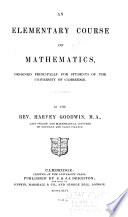 | Harvey Goodwin - Mathematics - 1846 - 500 pages
...according to either ascending or descending powers of some letter common to the two; the division of the first term of the dividend by the first term of the divisor gives the first term of the quotient ; multiply the divisor by this term, and subtract the product... | |
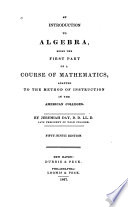 | Jeremiah Day - Algebra - 1847 - 358 pages
...terms, as shall be necessary to continue the operation : To obtain the first term of the quotient, divide the first term of the dividend, by the first term of the divisor ;* Divide again by the first term of the divisor, and proceed as before, tUl all the terms of the dividend... | |
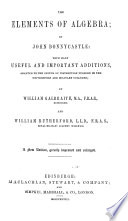 | John Bonnycastle - 1848 - 334 pages
...terms of each of them so that the higher powers of one of the letters may stand before the lower. 2. Divide the first term of the dividend by the first term of the divisor, and set the result in the quotient, with its proper sign, or simply by itself, if it be affirmative or... | |
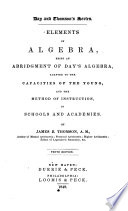 | Jeremiah Day, James Bates Thomson - Algebra - 1848 - 264 pages
...compound quantities, arrange the terms according to Art. 106. To obtain the first term in the quotient, divide the first term of the dividend by the first term of the divisor. Multiply the whole divisor by the term placed in the quotient ; subtract the • product from the dividend... | |
 | Joseph Ray - Algebra - 1848 - 250 pages
...they are found. From the preceding, we derive the BULB, FOR THE DIVISION OF ONE POLYNOMIAL BY ANOTHER. Divide the first term of the dividend by the first term of the divisor, the result will be the first term of the quotient. Multiply the divisor by this term, and subtract... | |
 | Joseph Ray - Algebra - 1848 - 252 pages
...From the preceding, we derive the BULK, FOR THE DIVISION OF ONE POLYNOMIAL BY ANOTHER. Divide tlie first term of the dividend by the first term of the divisor, the result will be the first term of the quotient. Multiply the divisor by this term, and subtract... | |
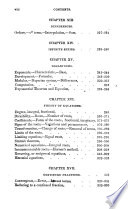 | Stephen Chase - Algebra - 1849 - 348 pages
...divisor according to the powers of some common letter, either ascending; or descending in both. 2. Divide the first term of the dividend by the first term of the divisor (§80), and set the result, with its proper sign, as a term of the quotient. '3. Multiply the divisor... | |
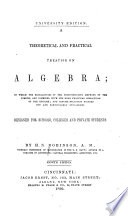 | Horatio Nelson Robinson - Algebra - 1850 - 358 pages
...truth of the following rule will become obvious by its great similarity to division in numbers. RULE. Divide the first term of the dividend by the first term of the divisor, and set the result in the quotient.* Multiply the whole divisor by the quotient thus found, and subtract... | |
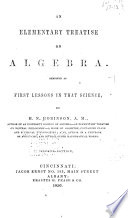 | Horatio Nelson Robinson - Algebra - 1850 - 256 pages
...of the following rule will become obvious by its great similarity to division in numbers. RULE . — Divide the first term of the dividend by the first term of the divisor, mid set the result in the quotient.* Multiply the whole divisor by the quotient thus found, and subtract... | |
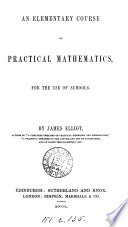 | James Elliot - 1850 - 116 pages
...both the divisor and the dividend according to the powers of some one letter contained in them : then divide the first term of the dividend by the first term of the divisor, for the first term of the quotient. Multiply the whole divisor by the term thus found. Subtract the... | |
| |